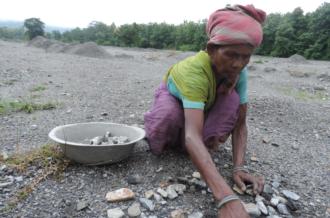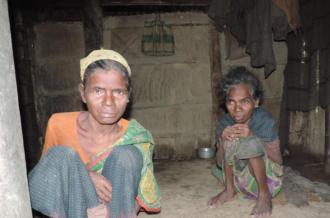India’s starving tea-garden workers
More than 100 workers have died of starvation since West Bengal’s tea estates have begun shutting down.

Jalpaiguri/Alipurduar, India – The picturesque tea gardens carpeting West Bengal’s Dooars region are gradually turning into graveyards, as dozens of workers have fallen victim to starvation in recent months.
More than 100 tea-garden workers have died of starvation in the past year amid site closures, activists say – but rather than taking action, the state government appears to be playing semantics.
Keep reading
list of 4 itemsPalestinian Prisoner’s Day: How many are still in Israeli detention?
‘Mama we’re dying’: Only able to hear her kids in Gaza in their final days
Europe pledges to boost aid to Sudan on unwelcome war anniversary
“There is no starvation death in the tea gardens of Bengal,” Health Minister Chandrima Bhattacharya told Al Jazeera, contending instead that the deaths were caused by “prolonged malnutrition”.
A fifth of India’s population of 1.2 billion are categorised as hungry – a definition that means they are consuming fewer than 1,800 calories a day, according to the UN Food and Agriculture Organisation (FAO).
A local NGO that studied about 1,200 households at the Bundapani estate in the Jalpaiguri district found residents were typically consuming about 250 calories a day – down from 2,500 when the tea garden was operational last July.
“While some families resorted to consumption of tea flowers, wild leaves, wild tubers and bamboo shoots, some said they were forced to survive on rats and snakes,” said a local NGO worker who spoke to Al Jazeera on condition of anonymity, for fear of backlash from government authorities.
With no official records, it is difficult to establish the scope of the problem. But anecdotal data suggests there has been an increase in starvation deaths since tea estates started shutting down in 2002, many unable to repay government loans.
Hunger-related illness
There are close to 300 still operating, but gardens have closed throughout the region, including in Bundapani, Dheklapara, Redbank, Surendranagar and Dharanipur. A study by the United Tea Workers Front (UTWF) in Dooars found that over the past decade, 1,000 workers have died.
“The fact is there are more than 100 deaths this year, owing to the closure of at least five tea gardens and abject poverty,” Anuradha Talwar, the State Adviser to the Supreme Court Commissioners on the Right to Food, told Al Jazeera. “As their wages are abysmally low, the poor workers or their family members have neither the fat on their bodies nor the balance in their banks to survive.”
Mukesh Goala, 27, was among the latest to succumb to hunger-related illness. A survey team commissioned by the Supreme Court to examine the spate of deaths in the gardens, led by Talwar, this month identified Goala as one of a dozen people who were on the verge of dying and in need of immediate assistance.
 |
| “The health minister did not lose her son, so she can never understand my pain,” Phulmuni Goala said [Chinmaya N Singh/ Al Jazeera] |
Hoping for swift action, the team sent its report to the state government in early August, but before anyone stepped in, Goala died.
“The health minister did not lose her son, so she can never understand my pain,” his mother, Phulmuni Goala, told Al Jazeera. “I lost my son to starvation. The state might call it whatever pleases them.”
Since the closure of the Bundapani tea garden where he worked, the mother-son duo had to go without food for days.
“At times, I would go to the forest to pluck shrubs and bamboo shoots to feed my ailing son,” said Goala, a former tea-garden worker herself who now ekes out a living by breaking stones in quarries. “Of late, that had also become impossible due to fear of attacks by elephants in the forest. With Mukesh, the only hope of my life is gone… I just pray to God to rid me of this life of misery.”
A similar spate of starvation deaths 10 years ago in Amlasole, West Midnapore – caused in that case by a famine-like situation – prompted the Supreme Court of India to order an inquiry, which ultimately found the government had failed to implement welfare schemes.
Since then, the government has taken sporadic action when tea-garden deaths have been reported in the media.
Activists say the tea workers already lived a hand-to-mouth existence, but the closures have pushed them to the cliff’s edge.
Massive payment delays
The tea gardens in Dooars guaranteed two square meals a day to nearly 5,000 workers and their families, each having four members on average. Now, they have no regular source of income.
Even before the closures, tea-garden workers earned poverty wages – about Rs 90 ($1.50) a day – that were insufficient to feed their families or provide medical care.
A large number of adult men who worked the tea gardens have been forced to look elsewhere, moving to Kerala, Bangalore and Gujarat for work while leaving their families behind.
 |
| Budhni and Hora Munda, tea-garden workers [Chinmaya N Singh/ Al Jazeera] |
“Most men from closed tea gardens have migrated to bigger cities in search of jobs,” Bishnu Ghatani of the Chai Bagan Bachao committee (Committee for Saving Tea Gardens) told Al Jazeera. “But they are somehow managing to survive there and can save little or no money to send back home to their starving families. The remaining population is working for pittance wages in stone collection and stone breaking, mainly in the river beds. We have also witnessed incidents of trafficking of girls and women.”
In addition to the widespread hunger, reliable drinking water is also hard to come by for tea-garden workers. Bundapani depends on contaminated river water from Bhutan, while other gardens have only a few functional hand pumps to quench the thirst of thousands.
The water problems coupled with a lack of sanitation have made residents prone to diseases such as tuberculosis, fungal and respiratory infections and diarrhea.
While the government provides food rations to almost all of the garden workers, other state measures designed to guarantee 100 days of work for unskilled rural labourers have failed, with many saying they received less than a third of that and faced massive delays in payment.
“I cannot send my children to school as it is too expensive for us now,” said Sudha Gope, a former plantation worker who now breaks stones in the riverbed along with her two young sons. “Earlier, when the tea garden was functional, our kids would board the company truck and go to school. But now you have to pay 20 rupees to and fro for the same. How can people who earn 90 rupees a day afford to spend [this] on sending one single kid to school?”
Follow Sanjay Pandey on Twitter: @sanjraj